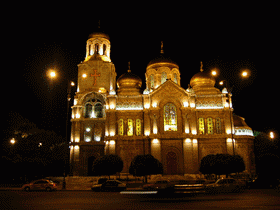ABOUT VARNA

The history of VARNA town
The city of Varna is situated along Varna Bay on the Black sea coast It is the administrative centre of the Varna district and the third largest city in Bulgaria after Sofia and the city of Plovdiv, with population about 400 000. The city is the largest port along the Bulgarian Black sea coast, it also has a railway station and an airport Varna is an important industrial centre with well-developed shipping, shipbuilding, and tourism. The city is a world-famous seaside resort and thousands of tourists spend their holidays every year in the resort complexes “Golden sands” and “St. st Constantine and Helena”. Varna is also the host city of numerous prestigious cultural events.
For over 7 000 years Varna has been the cradle of several civilizations. There are still well kept remains from the ancient, medieval and renaissance periods in the city’s history. Near the city of Varna was discovered the ancient necropolis with 280 tombs and 3 010 golden objects were found weighing over 6 kg altogether. According to experts it is the oldest processed gold ever found in Europe /second half of the 5th millenium B.C. /. About 560 years B.C. sprang up the town of Odessos in the area of an ancient Thracian settlement. It developed into a major agricultural, craftsman and commercial centre.
The town mints its own coins /drachmas/. During the 1st century B.C. Varna is seized by the Romans. In the 4th century A.D. the town becomes a bishopric. Towards the end of the 8th century Varna is included in the territory of the Bulgarian state. After the conversion to Christianity /864 A.D./ Varna turns into a religious centre. In 971 the town is conquered by the Byzantines. It is liberated by the army of Tsar Kaloyan in 1201. During the 13th and the 14th centuries Varna is a strong fortress and important commercial port having busy trade contacts with Venice and Genoa.
The architectural look of the city dates back to the end of the 19th and the beginning of the 20th century. Older architectural style presents the Clock tower in the centre of Varna and the church “The Holy Virgin”/1602/ with iconostasis dating back to 1896. There are 2 Armenian churches and 2 Catholic churches in the city. Original in architecture is also the building of the officers’ corps from the beginning of our century. At present in Varna there are 5 universities, theatre, opera house, several art galleries and museums.
The Cathedral “Assumption of the Holy Virgin”
This is the second largest church after the Cathedral “St. Alexander Nevski” in Sofia. It was built in the period 1884 – 1886 by master Gencho Kunev to commemorate the liberation from the Ottoman slavery. The cathedral is proclaimed a cultural monument. Its modern Byzantine architecture, stained glasses, icons and wooden iconostasis are of high historical and cultural value.
The Black sea received its name from the Scythians who lived in the areas along the coast. Its territory is 413 448 sq.km. The summer temperature of the sea water reaches 26 � 28 C. It is suitable for swimming until October when the temperature is between 17-19 C. There are about 140 types of fishes in the Black sea, among them dolphins. There are no sharks. The beach in Varna stretches for about 5 km and offers various places of entertainment and many small restaurants.
The Varna Museum is full of treasures from all periods of the city’s history. In 1972 excavations in the Varna Necropolis revealed almost two thousand gold artefacts from about 4000 B.C. One stunning display case has the bones of a tribal leader arranged with skilfully-made jewellery and personal possessions around him. Some of the finds are displayed under magnifying glass to reveal the complex and minute details of the craftsmanship. Some items are thought to be the oldest worked gold. Other exhibition halls contain Greek and Roman antiquities, including some fine ceramics; icons, weapons and materials from the 19th century struggle against the Ottoman Empire.
The Roman Therms – the largest found so far in Bulgaria. They were built at the end of the 2nd and the beginning of the 3id century. They take an area of 7 000 sq.m. At present they are turned into a museum.
Stone forest – About 20 kilometers west of Varna is the so-called Stone Forest, a curious collection of stone columns up to 7 meters high. The first impression is of a ruined temple but scientists have discovered that it is a geological formation of stalagmites some fifty million years old.
The Sea park in Varna is the largest of its kind. Its creation began in 1878. The present look of the park is due to the Czech gardener Yan Novak. In the Sea park of Varna are situated the Museum of the naval history, the Nature and science museum, the Dolphinarium with its entertaining dolphinshow, the Acquarium with its unique exhibition of sea species, astronomical observatory.
Important cultural events
International choir festival.
International film festival for youths and children. International theatral festival.
International music festival “Varna summer”.
International ballet competition.
International film festival ” Love is folly” .
International puppet theatre festival Biennale of black-and -white drawing.
Bulgarian film festival “Golden rose”
